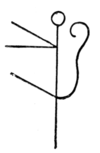ascended the throne. This seal shows his arms to be two lions passant. The English Royal crest, which originated with Richard I., is now always depicted as a lion statant guardant. There can be no doubt, however, that this guardant attitude is a subsequent derivation from the position of the lions on the shield, when heraldry was ceasing to be actual and becoming solely pictorial. We find in the case of the crest of Edward the Black Prince, now suspended over his tomb in Canterbury Cathedral, that the lion upon the chapeau looks straight forward over the front of the helm (see Fig. 271).
Another ancient rule belonging to the same period as the controversy between leopards and lions was that there cannot be more than one lion upon a shield, and this was one of the great arguments used to determine that the charges on the Royal Arms of England must be leopards and not lions. It was admitted as a rule of British armory to a limited extent, viz., that when two or more lions rampant appeared upon the same shield, unless combatant, they were always formerly described as lioncels. Thus the arms of Bohun are: "Azure, a bend argent, cottised between six lioncels rampant or." British heraldry has, however, long since disregarded any such rule (if any definite rule ever really existed upon the point), though curiously enough in the recent grant of arms to the town of Warrington the animals are there blazoned six "lioncels."
The artistic evolution of the lion rampant can be readily traced in the examples and explanations which follow, but, as will be understood, the employment in the case of some of these models cannot strictly be said to be confined within a certain number of years, though the details and periods given are roughly accurate, and sufficiently so to typify the changes which have occurred.
Until perhaps the second half of the thirteenth century the body of the lion appears straight upright, so that the head, the trunk, and the left hind-paw fall into the angle of the shield. The left fore-paw is horizontal, the right fore- and the right hind-paw are placed diagonally (or obliquely) upwards (Fig. 272). The paws each end in three knobs, similar to a clover-leaf, out of which the claws come forth. The fourth or inferior toes appeared in heraldry somewhat later. The jaws are closed or only very slightly opened, without the tongue being visible. The tail is thickened in the middle with a bunch of longer hair and is turned down towards the body.
In the course of the period lasting from the second half of the thirteenth to the second half of the fourteenth centuries, the right hind-paw sinks lower until it forms a right angle with the left. The mouth

